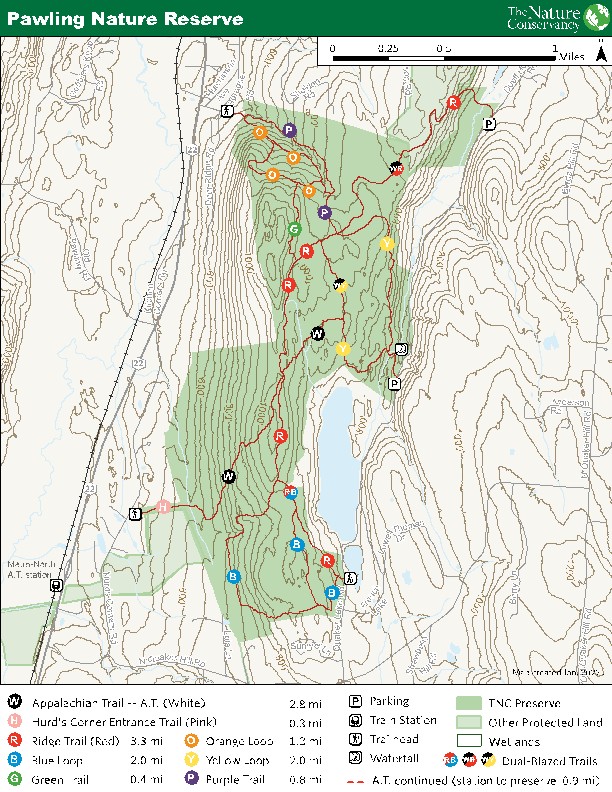This 1,060-acre preserve is located in the towns of Pawling and Dover, Dutchess County, New York. There are five separate trailheads to access the preserve.
Hours of Visitation
This preserve is open from dawn to dusk, year round.
Guidelines
To help ensure that this special place can be enjoyed for future generations, please leave no trace and carry out what you carry in. Camping, littering, hunting, fires, or removal or destruction of plants or animals are prohibited. See our full preserve visitation guidelines for more information.
Visiting by Train
The “Appalachian Trail” stop on the MetroNorth railroad provides access to the AT and trails in Pawling Nature Reserve for hikers. The train station is 0.9 hiking miles away from the preserve. Follow the AT northbound, crossing Route 22 and some farm fields before entering Pawling Nature Reserve.
Check train schedules on the MTA website. The train only runs a few times a day on weekends, so plan accordingly.
Trailhead information and Parking
· The Quaker Lake Rd trailhead is considered the “main entrance” for Pawling Nature Reserve and serves as the access point for the Yellow Trail. Connection can be made to the Appalachian Trail (AT) as well. From this trailhead, access views of the Duell Hollow Brook gorge and waterfall. Enjoy some educational signage along the trail, including a tree species guessing game. There is parking available for 3-4 cars in the small lot marked with The Nature Conservancy signs.
· The Duell Hollow Brook Rd trailhead is the access point for the northern end of the Red Trail. Connection can be made to the AT as well.
· The Furlong Rd trailhead is in a quiet residential area and is the access point for the Orange and Purple Trails. There is streetside parking for 1 car.
· The Hurds Corners Rd trailhead is the access point for the Pink Trail and is the quickest approach to the AT. There is parking for 2-3 cars on the side of the road.
· The French Lake trailhead on Quaker Lake Rd provides access to the southern end of the Red Trail as well as the Blue Loop trail. There is streetside parking available for 1-2 cars.
What to See
With over 12 miles of trail through the Pawling Nature Reserve, there is great opportunity to observe a selection of different natural ecological communities.
Red maple-hardwood swamps with ashes, elms, and yellow birch intersect with a chestnut oak forest atop the Hammersley Ridge. The diversity of deciduous hardwood tree species makes for an especially colorful autumn.
When the leaves fall, views of the Great Swamp and the surrounding Harlem Valley are abundant. As winter falls, expect icicles and interesting ice features among the many streams and springs, especially around the boulder-laden rock outcroppings.
Come spring, the reserve is an excellent place to observe spring ephemerals, colorful flowers on the forest floor that bloom not long after snow melts away. Later in spring, the mountain laurel shrubs atop the ridge feature magnificent blooms.
The thick green shade of the forest provides a refuge in summertime, when all sorts of insects, reptiles, and amphibians are active.
The reserve’s gorge is a sight to behold, best observed on the Yellow Loop. The trail also features 10 small educational signs about the different communities of the forest, as well as a tree species guessing game that showcases most of the tree species in the reserve.
The Appalachian Trail is another amazing feature of the Pawling Nature Reserve. This 2190-mile National Scenic Trail is the longest hiking-only footpath in the world, traveling through 14 states from Georgia to Maine. Every year, over 3,000 people attempt to thru-hike the entire trail, usually over the course of 5-7 months. Many more people enjoy the trail in sections, on day hikes to viewpoints, historic shelters, or ecologically interesting locations. Be on the look out for thru-hikers in the reserve, especially during the summer months.


